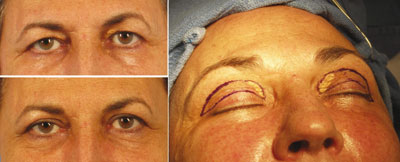Functional and cosmetic surgery intersect in a positive way
Surgeons must be aware of the aesthetic implications of all oculoplastic procedures.
Intraocular surgery, at its best, improves the way in which our patients see the world. In contrast, eyelid and oculofacial plastic surgery can change the way in which our patients are seen by the world.
Many oculoplastic procedures are primarily performed to remedy a functional issue, but all of these procedures have a cosmetic aspect. The oculofacial surgeon must be mindful of the aesthetic implications of any tissue manipulation and the resultant changes left behind. At times, this responsibility can seem an insurmountable task, but on the contrary, the intersection of functional and aesthetic surgery is a great source of personal and professional reward.
Anterior and posterior segment surgeries seldom leave visible traces of the surgeon’s incisions. Eyelid and facial operations can produce scars that are in plain sight. The art of incision placement within pre-existing anatomic creases and between anatomic subunits is taught early in residency training. Upper blepharoplasty, for example, is always initiated with identification of the eyelid crease. The incision should ideally be disguised in this natural line.
We, as surgeons, are obliged to consider these principles in every surgery we perform.
Varied techniques
Take for example the case of a skin defect of the temple, resulting from a Mohs’ resection of a malignant lesion. With the daunting prospect of achieving any reconstruction, let alone an aesthetically acceptable one, one is tempted to use a skin-grafting technique.
In some instances, this may be a viable approach, but the notion of local flap reconstruction should be entertained. Local flaps generally result in a more favorable contour, pigmentary continuity and textural match.
Techniques borrowed from cosmetic procedures often can be applied to reconstructive cases. In the case of a temporal skin deficiency, a rhytidectomy approach to a cervicofacial flap mobilizes sufficient skin while mimicking the lines of native periauricular landmarks, maximizing the likelihood of a successful aesthetic result (Figure 1).
|
Image: Kotlus BS |
Achieving an aesthetic result does not always require a complicated approach. A simple plan can also be a highly successful one, such as a rhombic or transpositional flap (Figure 2).
|
Image: Schwarcz R |
An aesthetic approach sometimes demands that we remove our loupes or step back from the operating microscope and look at our patient in a wider scale. In the case of a skin lesion destined for excision, it is advisable to survey the surrounding structures.
|
Image: Kotlus BS |
The commonly encountered xanthelasma seen at the medial upper eyelid is considered unsightly by many patients seeking your expert advice. Direct removal of the lesion has the potential to disrupt the beautifully sloping curve of the upper eyelid crease. But when upper eyelid dermatochalasis is simultaneously present, a combined upper blepharoplasty with excision of the lesion is an elegant, cosmetically sound approach (Figure 3).
Transitioning to a cosmetic-oriented approach
Cosmetic surgery as a discipline is being embraced by a growing number of our colleagues. The result is a class of oculofacial specialists with finer skills and the ability to address patient needs with the utmost quality of care.
The transition to a cosmetically oriented approach is gradual, beginning with a foundation of skills learned in internship and residency. Fellowships and multidisciplinary mentorships expand upon the basics, allowing physicians to incorporate more sophisticated techniques into their repertoires as they see fit.
Many oculofacial surgeons may never perform a neck lift to correct a “turkey waddle,” but they are trained to do so and can summon these skills when a suitable situation presents itself.
Aesthetic medicine has strong roots in ophthalmology. Injection of botulinum toxin, currently the most performed procedure in the cosmetic industry, stemmed from strabismus therapy.
Medical lasers were first used for retinal applications and have since become a mainstay in skin rejuvenation. Blepharoplasty is one of the top five most common cosmetic procedures in the country.
As much as ophthalmologists have contributed to the field of cosmetic surgery, it is important for ophthalmologists to remember to take something back. Cosmetic principles can be applied to everyday functional procedures in a positive and seamless fashion.

- Brett S. Kotlus, MD, MS, can be reached at Allure Medical Spa, 8180 26 Mile Road, Shelby Township, MI 48316; e-mail: drkotlus@alluremedicalspa.com.



